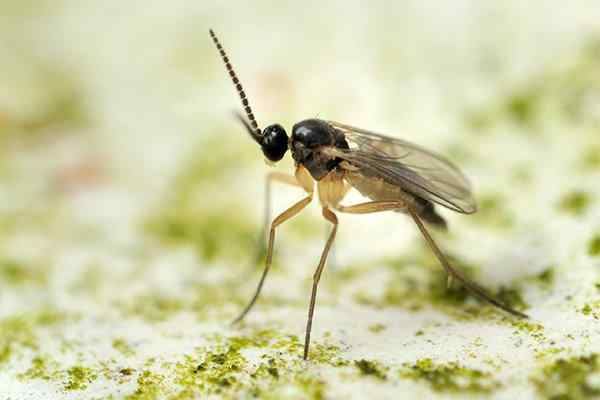By Steve Racioppe M.S.

In this last segment of our 3-part series on flies we’ll cover the remaining small flies - phorid flies, moth flies, and fungus gnats.
Phorid Flies (Family Phoridae)
The most significant of the remaining three is the phorid fly. The phorid fly is often confused with the fruit fly, but there are key points that differentiate the two. The phorid fly is about 1/8” in length with tan to brown wings. Its eyes will be black unlike many fruit flies. The most noticeable traits are its small head and humped thorax. In fact they’re sometimes called the humpback fly. The other key differentiator is their breeding site. Phorid flies are usually associated with some sort of wet, heavy organic contamination. They’re also known as crypt flies for their predilection for breeding in corpses.
Phorid flies are very common in restaurants and commercial buildings. In hospitals they are an enormous concern because they are known to breed in patients’ wounds and can mechanically transmit harmful germs. They can breed in any type of decaying organic liquid, so drains, garbage cans, and soda towers are in play. Having said that, plumbing and pipe breaks are a very likely possibility as raw sewage is a favored breeding material.
Like all small flies source elimination is the only real solution. When inspecting for phorid flies start by asking if there have been any known plumbing breaks or issues. It is very common for phorid flies to be associated with a plumbing issue below the slab. If there have been known plumbing breaks start with that area. Look for broken tiles and areas where repairs have been attempted. If you see high levels of activity that’s probably the source. Here’s the bad news for the client- it’s not really a pest problem, it’s 100 percent a plumbing problem. The area will have to be torn up and fixed, and the contaminated soil removed. This is an expensive proposition, so be darn sure you’ve eliminated other possibilities.
Professional tools such as cameras may have to be used to confirm a break in the line. If there appears to be no plumbing issues look for areas with liquids containing high organic levels, like drains. Continue looking at all of these types of areas you can find.
A tool that can help you dial in the source is fly lights. They aren’t terribly attractive to phorid flies, but they may help you find areas of high concentration. Another trick is to put duct tape over cracks and void openings. If after several days you find flies stuck to the tape, that area could be a source.
Treatment will often be the plumbing repair. For areas not associated with plumbing, like drains, the best remediation is cleaning and maintenance. Until that happens, however, drain enzyme products can help reduce the breeding medium. Aerosols and fogging can also be used to reduce populations for immediate relief, but this is a temporary solution that’ll only help for a day or two.
Moth Flies (Family Psychodidae)
Moth flies are the true drain fly, so called because drains are a primary breeding site. Moth flies are very small, slightly under 1/8”. Their coloration is much like that of a moth with brown, tan, and white patterns on their hairy body. They are poor fliers often found near their breeding site. When inspecting for moth flies think slime. They develop in the gelatinous goo that builds up in moist, poorly cleaned areas. That’s why drains are such a key area. But beware of other areas where moisture collects, such as tile with missing grout.
Treatment consists of cleaning the area in question, removing the breeding medium, and maintaining proper drainage. Again, the enzyme products can help reduce the organic material. A monthly enzyme drain treatment is an excellent sales opportunity.
Fungus Gnats (Families Mycetophilidae and Sciaridae)
The last of the small flies we’ll discuss are the fungus gnats. Physically, they are dark, very small (about 1/16”) with long legs and long antennae. While not a harmful pest, they can be extremely irritating because they can get in your eye or accidentally inhaled. Persons being bothered by fungus gnats spend a lot of time trying to shoo them away from their face. For a patron of a business that’s not a great experience.
They live almost exclusively in and around overwatered soil. The overwatering fosters a fungus which the flies feed upon. It also provides the breeding medium. The solution? Dry out the soil. There’s really no need for any insecticide treatment, the mere act of drying the soil will take away their food and their breeding site.
Summary
We hope you’ve enjoyed this series. If you have any questions or would like an ID, please don’t hesitate to email us here.
Remember we also have PCT’s Structure Infesting Flies Field Guide for anyone that would like one. Simply drop an email here and we’ll get it on the way!
Steve Racioppe, M.S.
Steve Racioppe is General Manager and staff entomologist for Geotech Supply. He earned his undergraduate and master’s degree in fly biology from Rutgers University. He spent time as a technical director for a large firm in Texas, was Sales Director for Whitmire Micro-Gen and BASF, and has been G.M. for Geotech Supply since 2012. For questions or identifications contact Steve at sracioppe@geotechsupply.com.


*We still have copies left, so if you’d like a free copy of PCT’s Structure Infesting Flies guide*,
email us here.

